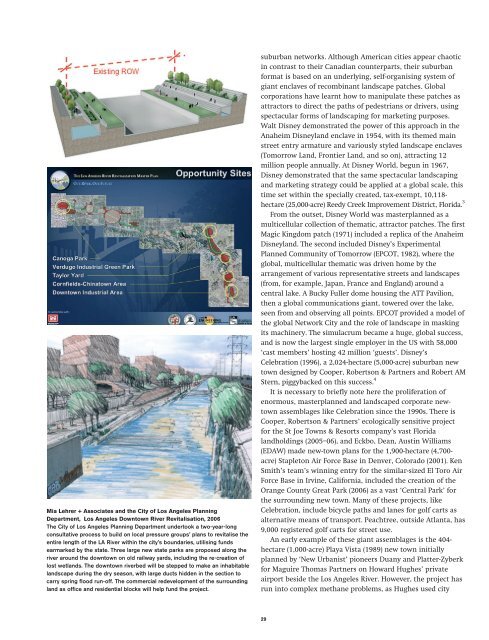Landscape Architecture: Landscape Architecture: - School of ...
Landscape Architecture: Landscape Architecture: - School of ...
Landscape Architecture: Landscape Architecture: - School of ...
- No tags were found...
You also want an ePaper? Increase the reach of your titles
YUMPU automatically turns print PDFs into web optimized ePapers that Google loves.
Mia Lehrer + Associates and the City <strong>of</strong> Los Angeles Planning<br />
Department, Los Angeles Downtown River Revitalisation, 2006<br />
The City <strong>of</strong> Los Angeles Planning Department undertook a two-year-long<br />
consultative process to build on local pressure groups’ plans to revitalise the<br />
entire length <strong>of</strong> the LA River within the city’s boundaries, utilising funds<br />
earmarked by the state. Three large new state parks are proposed along the<br />
river around the downtown on old railway yards, including the re-creation <strong>of</strong><br />
lost wetlands. The downtown riverbed will be stepped to make an inhabitable<br />
landscape during the dry season, with large ducts hidden in the section to<br />
carry spring flood run-<strong>of</strong>f. The commercial redevelopment <strong>of</strong> the surrounding<br />
land as <strong>of</strong>fice and residential blocks will help fund the project.<br />
suburban networks. Although American cities appear chaotic<br />
in contrast to their Canadian counterparts, their suburban<br />
format is based on an underlying, self-organising system <strong>of</strong><br />
giant enclaves <strong>of</strong> recombinant landscape patches. Global<br />
corporations have learnt how to manipulate these patches as<br />
attractors to direct the paths <strong>of</strong> pedestrians or drivers, using<br />
spectacular forms <strong>of</strong> landscaping for marketing purposes.<br />
Walt Disney demonstrated the power <strong>of</strong> this approach in the<br />
Anaheim Disneyland enclave in 1954, with its themed main<br />
street entry armature and variously styled landscape enclaves<br />
(Tomorrow Land, Frontier Land, and so on), attracting 12<br />
million people annually. At Disney World, begun in 1967,<br />
Disney demonstrated that the same spectacular landscaping<br />
and marketing strategy could be applied at a global scale, this<br />
time set within the specially created, tax-exempt, 10,118-<br />
hectare (25,000-acre) Reedy Creek Improvement District, Florida. 3<br />
From the outset, Disney World was masterplanned as a<br />
multicellular collection <strong>of</strong> thematic, attractor patches. The first<br />
Magic Kingdom patch (1971) included a replica <strong>of</strong> the Anaheim<br />
Disneyland. The second included Disney’s Experimental<br />
Planned Community <strong>of</strong> Tomorrow (EPCOT, 1982), where the<br />
global, multicellular thematic was driven home by the<br />
arrangement <strong>of</strong> various representative streets and landscapes<br />
(from, for example, Japan, France and England) around a<br />
central lake. A Bucky Fuller dome housing the ATT Pavilion,<br />
then a global communications giant, towered over the lake,<br />
seen from and observing all points. EPCOT provided a model <strong>of</strong><br />
the global Network City and the role <strong>of</strong> landscape in masking<br />
its machinery. The simulacrum became a huge, global success,<br />
and is now the largest single employer in the US with 58,000<br />
‘cast members’ hosting 42 million ‘guests’. Disney’s<br />
Celebration (1996), a 2,024-hectare (5,000-acre) suburban new<br />
town designed by Cooper, Robertson & Partners and Robert AM<br />
Stern, piggybacked on this success. 4<br />
It is necessary to briefly note here the proliferation <strong>of</strong><br />
enormous, masterplanned and landscaped corporate newtown<br />
assemblages like Celebration since the 1990s. There is<br />
Cooper, Robertson & Partners’ ecologically sensitive project<br />
for the St Joe Towns & Resorts company’s vast Florida<br />
landholdings (2005–06), and Eckbo, Dean, Austin Williams<br />
(EDAW) made new-town plans for the 1,900-hectare (4,700-<br />
acre) Stapleton Air Force Base in Denver, Colorado (2001). Ken<br />
Smith’s team’s winning entry for the similar-sized El Toro Air<br />
Force Base in Irvine, California, included the creation <strong>of</strong> the<br />
Orange County Great Park (2006) as a vast ‘Central Park’ for<br />
the surrounding new town. Many <strong>of</strong> these projects, like<br />
Celebration, include bicycle paths and lanes for golf carts as<br />
alternative means <strong>of</strong> transport. Peachtree, outside Atlanta, has<br />
9,000 registered golf carts for street use.<br />
An early example <strong>of</strong> these giant assemblages is the 404-<br />
hectare (1,000-acre) Playa Vista (1989) new town initially<br />
planned by ‘New Urbanist’ pioneers Duany and Platter-Zyberk<br />
for Maguire Thomas Partners on Howard Hughes’ private<br />
airport beside the Los Angeles River. However, the project has<br />
run into complex methane problems, as Hughes used city<br />
29



